A Product Manager’s Guide To Stakeholder Management
Stakeholder management is a product manager’s lifesaver that can help them effectively connect with various people involved with a product. Communicating with executives, investors, and other stakeholders is always challenging, regardless of your experience as a product manager. Keeping cross-functional teams on the same page doesn’t sound like an easy feat, either! Thankfully, stakeholder management proves to be a viable solution for communicating with various stakeholders and managing their expectations.
What is a product stakeholder?
Before we discuss stakeholder management, let’s drive around the basics first, particularly the definition of a stakeholder.
A stakeholder is an individual, group, or organisation affected by a business or project’s success or outcome. In the same sense, product stakeholders are the people who are impacted by a product, either directly or indirectly. They are anyone in the industry who can influence your product through their opinions and decisions.
Product stakeholders aren’t limited to those you work with within the office. These parties can vary widely, ranging from customers to internal teams like marketing, as well as executives and investors.
Types of stakeholders
There are six main types of stakeholders, and these groups often function as gatekeepers, decision-makers, sponsors, influencers, or product users. Let’s explore each of them below:
Primary stakeholders
Primary stakeholders directly participate in the operation of a business and the products it delivers. They have a direct financial interest in the success or failure of the product because of the resources they’ve invested. For this reason, they must always be involved when making key product decisions.
You can consider the individuals below as primary stakeholders:
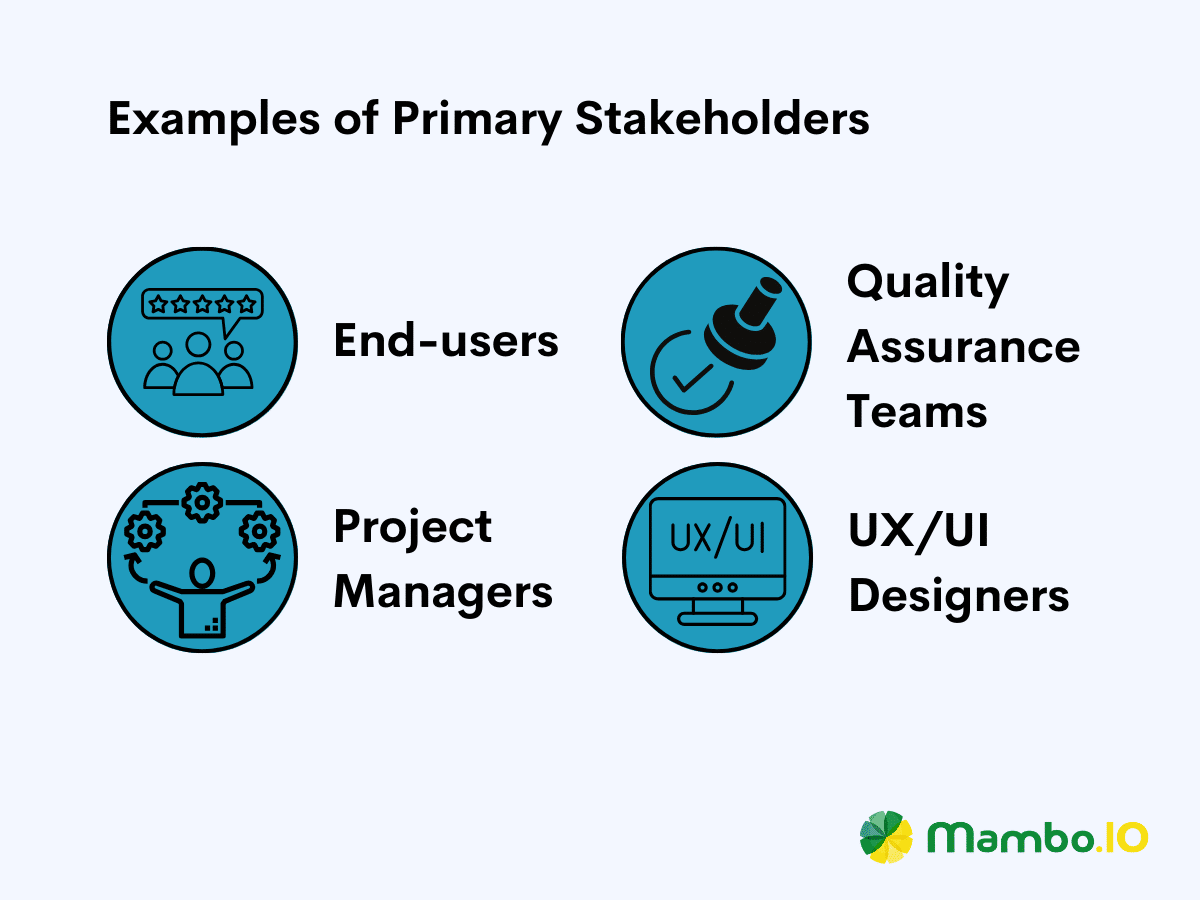
Secondary stakeholders
Secondary stakeholders, on the other hand, aren’t directly involved with the product and its development. Moreover, they’re much less passive and less impactful than primary stakeholders. They don’t stand to gain or lose anything significant with whatever status your product achieves.
Here are some people you can consider as secondary stakeholders:
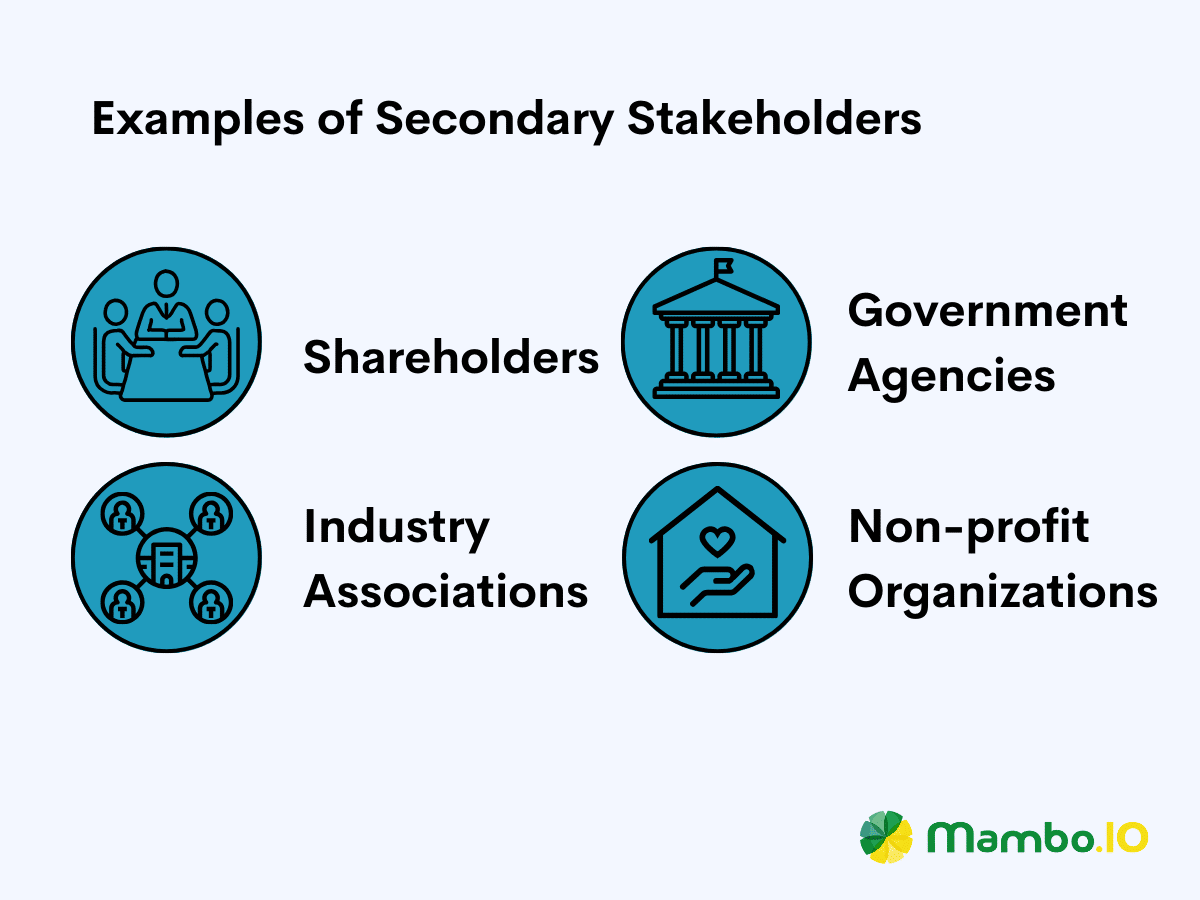
Internal stakeholders
Internal stakeholders are the people who act as gears that keep the product development machine turning. They are the top-level executives and management responsible for allocating vital resources, providing strategic direction, and steering your product’s course.
Below are some examples of internal stakeholders:
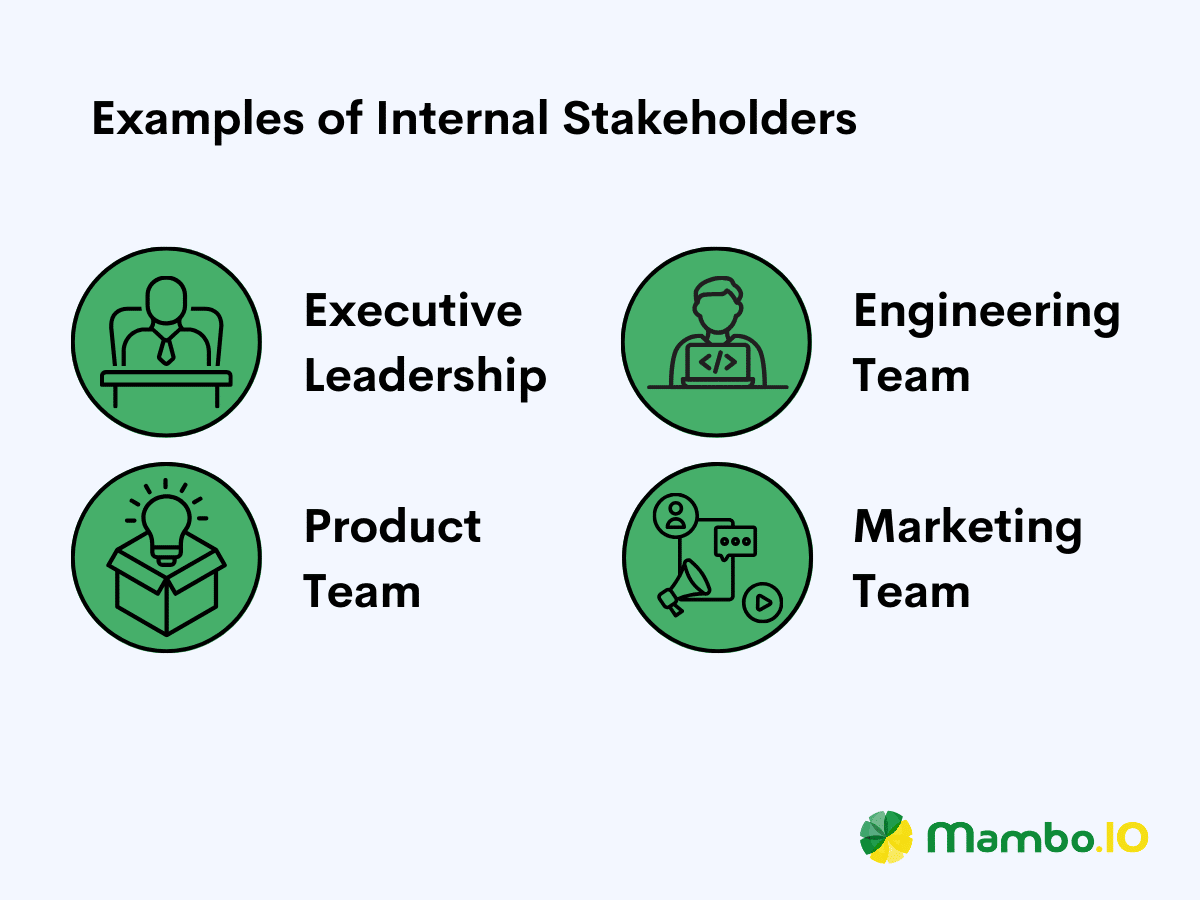
External stakeholders
These people are situated outside your organisation but sway over your product’s status from a distance. Their actions and offerings shape the competitive landscape in which your product resides.
Here are some examples of external stakeholders:
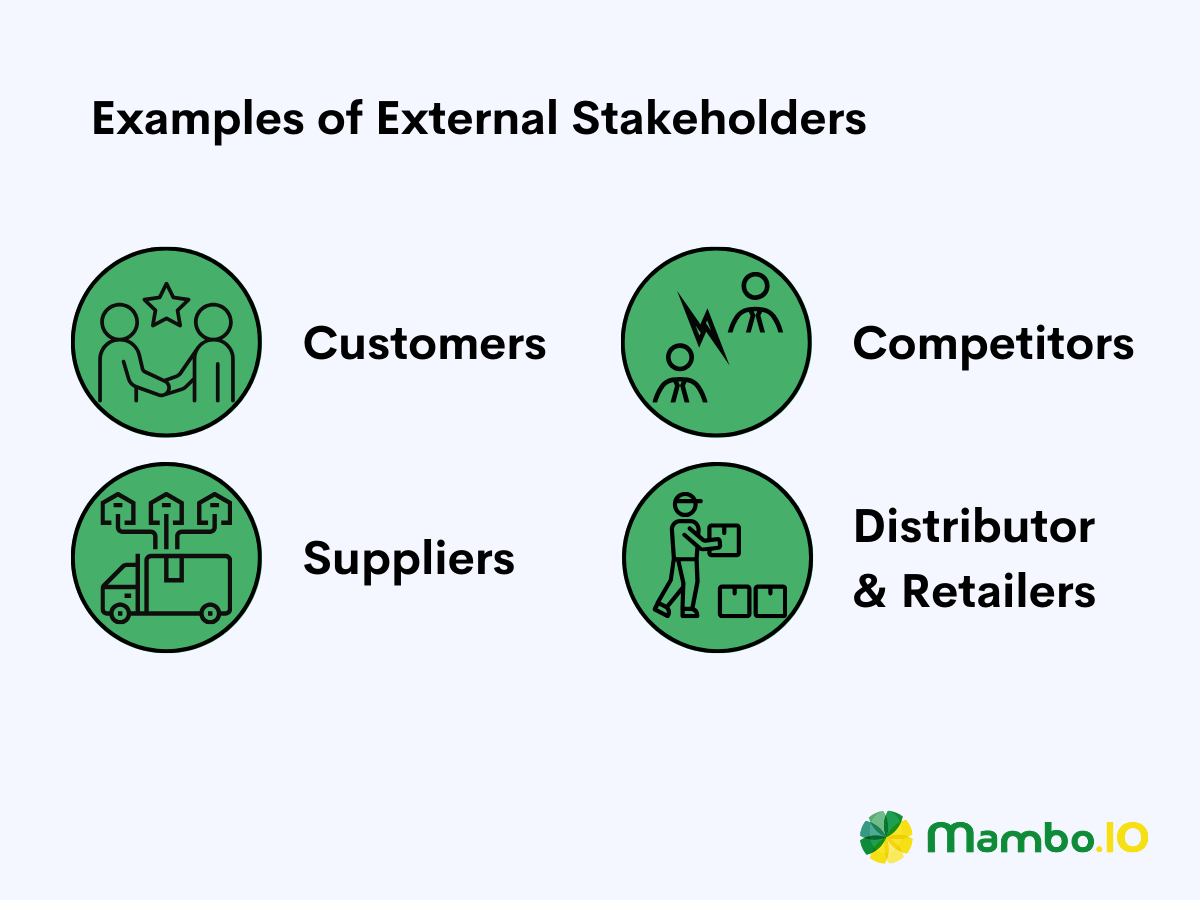
Direct stakeholders
Direct stakeholders operate at the forefront of your product’s development. Their decisions have an immediate and substantial impact on your product’s lifecycle and development lifecycle.
Some notable examples of direct stakeholders are the following:
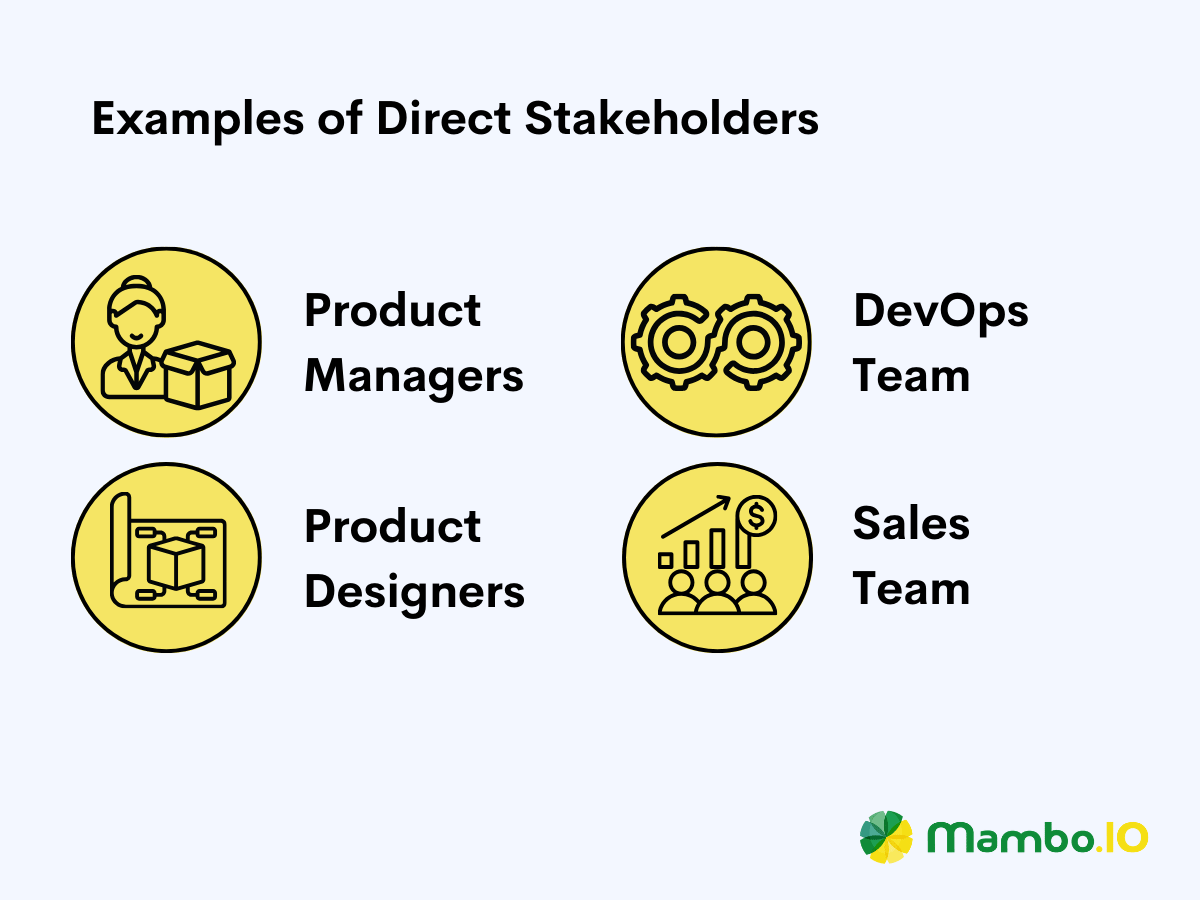
Indirect stakeholders
While not at the forefront, indirect stakeholders influence your product subtly. They often represent your customer base and shape the market perception, indirectly influencing your product’s decision.
You can consider the people below as candidates for indirect stakeholders:
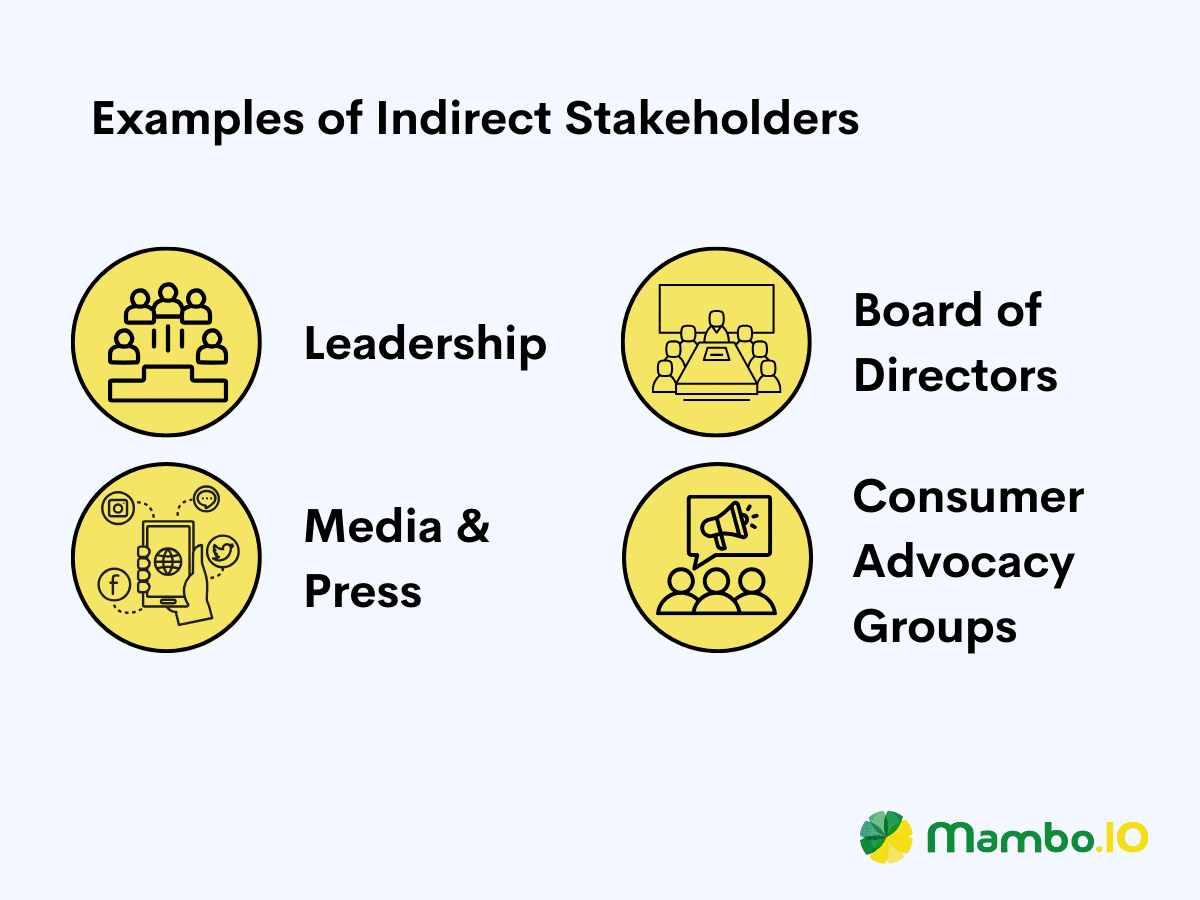
Who are the key stakeholders?
The key stakeholders product managers will need to work with are as follows:
- Chief Technology Officer (CTO) – They provide necessary technical expertise and guidance.
- Chief Marketing Officer (CMO) – They can link the product to its target audience.
- Chief Executive Officer (CEO) – They can help drive the product toward company growth and profitability.
- Head of sales – They drive product success in terms of revenue generation.
- Head of product development – They help translate the product vision into a tangible product.
- Head of customer support – They ensure the product meets the customer’s needs.
- Head of production – They ensure the product is well-designed and feasible.
What is stakeholder management?
Most product managers don’t have any subordinates working under them. But even then, it’s critical that they learn leadership skills to collaborate effectively with product stakeholders.. Throughout the product life cycle and product development life cycle, you will need the active participation of these people. Their involvement will increase the likelihood of your product achieving favourable outcomes.
Stakeholder management is a strategic process that involves identifying, assessing, engaging, and managing the stakeholders interested in the product’s success. This ongoing process demands a blend of diplomacy, strong communication skills, and a profound grasp of the product’s ecosystem. An effective stakeholder management process allows you to organise interactions and evaluate your relationships with stakeholders.
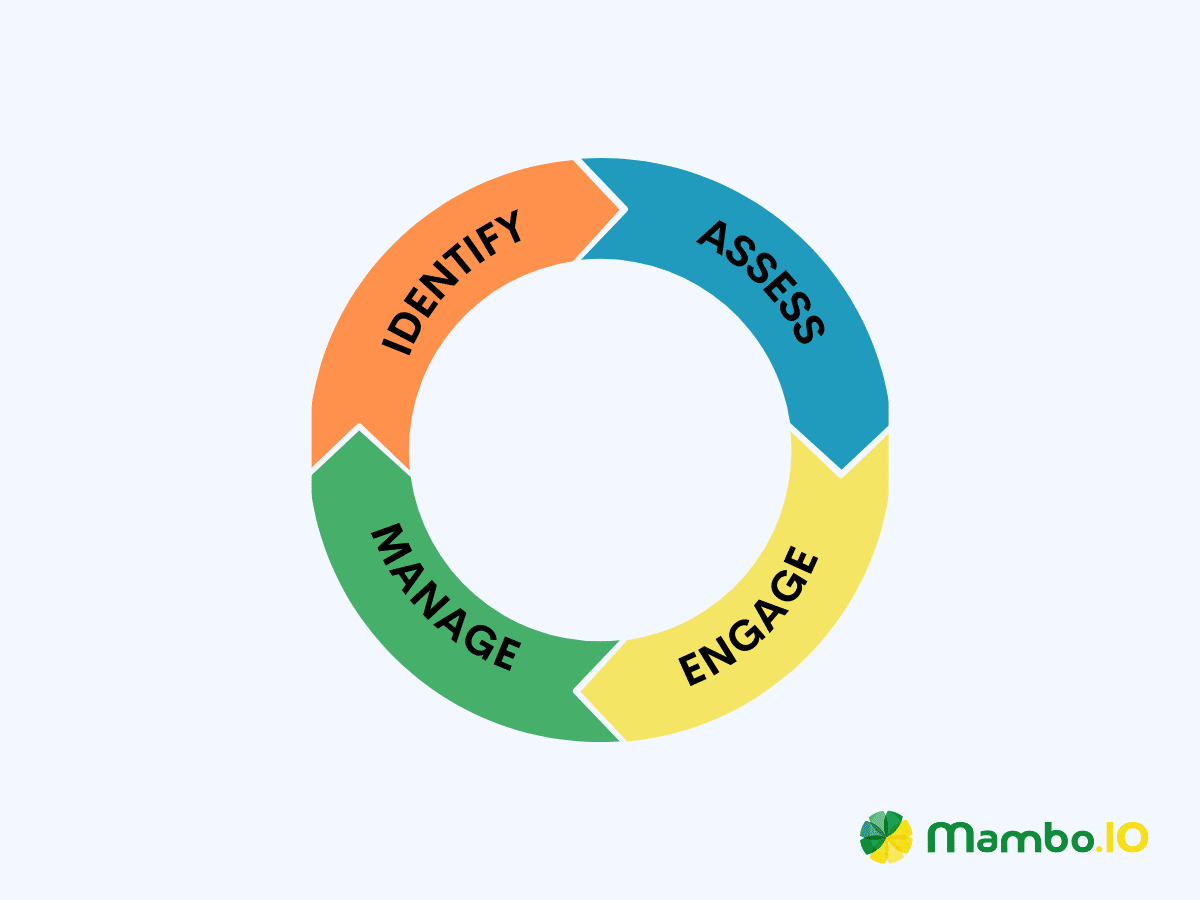
Why is stakeholder management important?
Stakeholder management provides product managers with an in-depth understanding of the stakeholders. Understanding them is important because they have great influence over the resources needed to bring the product to market. So, product managers must follow a methodical approach when interacting with these important people.
When executed effectively, stakeholder management aligns expectations and keeps consensus amongst everybody. It also helps ease the minds of stakeholders and eliminate the need for micromanaging on the product manager’s part. Follow this up with a sound engagement plan to foster strong relationships with the people who believe in your product’s potential.
Benefits of stakeholder management
The trajectory of a product involves the relationships of the stakeholders built around it. If implemented correctly, stakeholder management can be the key to fostering these relationships into something highly beneficial to everyone involved. Here are some of the notable benefits of utilising stakeholder management.
#1. Alignment
Alignment is the first thing every product manager must strive for when building an efficient and effective team. If everyone isn’t on the same page, the stakeholders may accomplish their commitments according to their perceived product vision. And as you may have guessed it, scenarios like these are a recipe for disaster of epic proportions!
Stakeholder management ensures everyone understands the product’s purpose, objectives, and desired outcomes. Ensuring alignment with the product vision means fewer conflicts, and all efforts point towards a common goal.
#2. Risk mitigation
Identifying risks and issues as early as possible is key to building and launching a successful product. With stakeholder management, you can mitigate these risks and anticipate potential challenges early in the product life cycle. Allowing yourself to engage and listen to your stakeholder’s concerns will give you the advantage of proactively addressing their challenges.
#3. Proper time and resource allocation
When stakeholders make important decisions, allocating resources becomes much easier. Their input helps determine where to allocate resources to maximise their impact. This leads to better time management and resource utilisation, ultimately leading to efficient project execution.
#4. Enhanced communication and stronger relationships
Product managers who engage their stakeholders well promote transparent and open communication among all parties. If you establish clear communication channels, stakeholders can freely voice their opinions and inquiries. This openness fosters a collaborative environment that encourages the exchange of ideas and minimises misunderstandings.
#5. Buy-in support
The business environment has always been dynamic and complex because everyone has varying opinions and interests. In this tough landscape, you’ll need the consensus and support of your stakeholders.
With stakeholder management, you can involve your stakeholders in the decision-making process. Doing so ensures they have a sense of ownership and commitment, making them look forward to the product’s success. When their input is valued, they are more likely to support and advocate for your product actively. Ultimately, stakeholder buy-ins will be instrumental in overcoming obstacles and gaining broader support for your plans and initiatives.
#6. Manageable expectations
It’s pretty common for people to think that developing a product will require less time and money than it needs. When projects roll with this mindset, stakeholders get frustrated if product development lags behind schedule or exceeds the budget significantly.
Winning product managers utilise stakeholder management to set and manage stakeholder expectations effectively. With this process, they can set the project scope, objectives, and timelines so stakeholders can establish realistic expectations. When product managers manage expectations effectively, the disappointment stakeholders experience when their assumptions aren’t met reduces.
#7. Needs and concerns properly addressed
It’s normal for each stakeholder to have their fair share of concerns that are unique to them. With stakeholder management, you can identify and address the issues of all parties involved in the product lifecycle. Proactive approaches like these guarantee that stakeholder requirements are met.
#8. Stakeholder satisfaction
Let’s face it; you can’t please everyone, not even all your stakeholders. But with stakeholder management, you can increase the likelihood of keeping your stakeholders happy, content, and involved in your projects. Satisfied stakeholders mean less stress for you as a product manager.
The stakeholder management process explained
#1. Stakeholder analysis
Stakeholder analysis is the foundational step in understanding the various individuals and groups who’ve voted for your product. This stakeholder management process helps product managers identify and prioritise stakeholders based on their participation, interest level, and influence.

Afterwards, your next step is to create a plan to involve each stakeholder in the project best. The expertise of each key player is crucial in keeping the product on track and far from potential pitfalls. If you want the project to proceed smoothly, you’ll need the help of exceptional people. These people are stakeholders, and they have the personnel and resources necessary to develop a successful product.
Stakeholder analysis can also help build trust with stakeholders. It does so by opening lines of communication between you and them. When this happens, you can establish rapport with them and demonstrate transparency, thus fostering trust between parties.
#2. Stakeholder identification
After an analysis, you must identify each stakeholder and their specific roles and responsibilities related to your product. This will leave you with a comprehensive list of stakeholders both inside and outside your organisation
Are you clueless about where to start? Consider the tips below to get started on your task of identifying your product stakeholders.
- Review project documents such as project charter, contract documents, and organisation process assets and look for stakeholder information.
- Conduct a brainstorming session with your team and formulate questions to identify your internal and external stakeholders.
- Communicate with stakeholder representatives to gain more information about stakeholders.
- Review the stakeholder register since it contains essential information about your stakeholders.
#3. Stakeholder mapping
Stakeholder mapping is the next step after identifying your stakeholders. It’s creating a visual representation that categorises stakeholders based on their influence and interest in the product. Mapping the stakeholders according to their categories will help you prioritise and communicate your strategies.
Here’s what a stakeholder mapping template can look like:
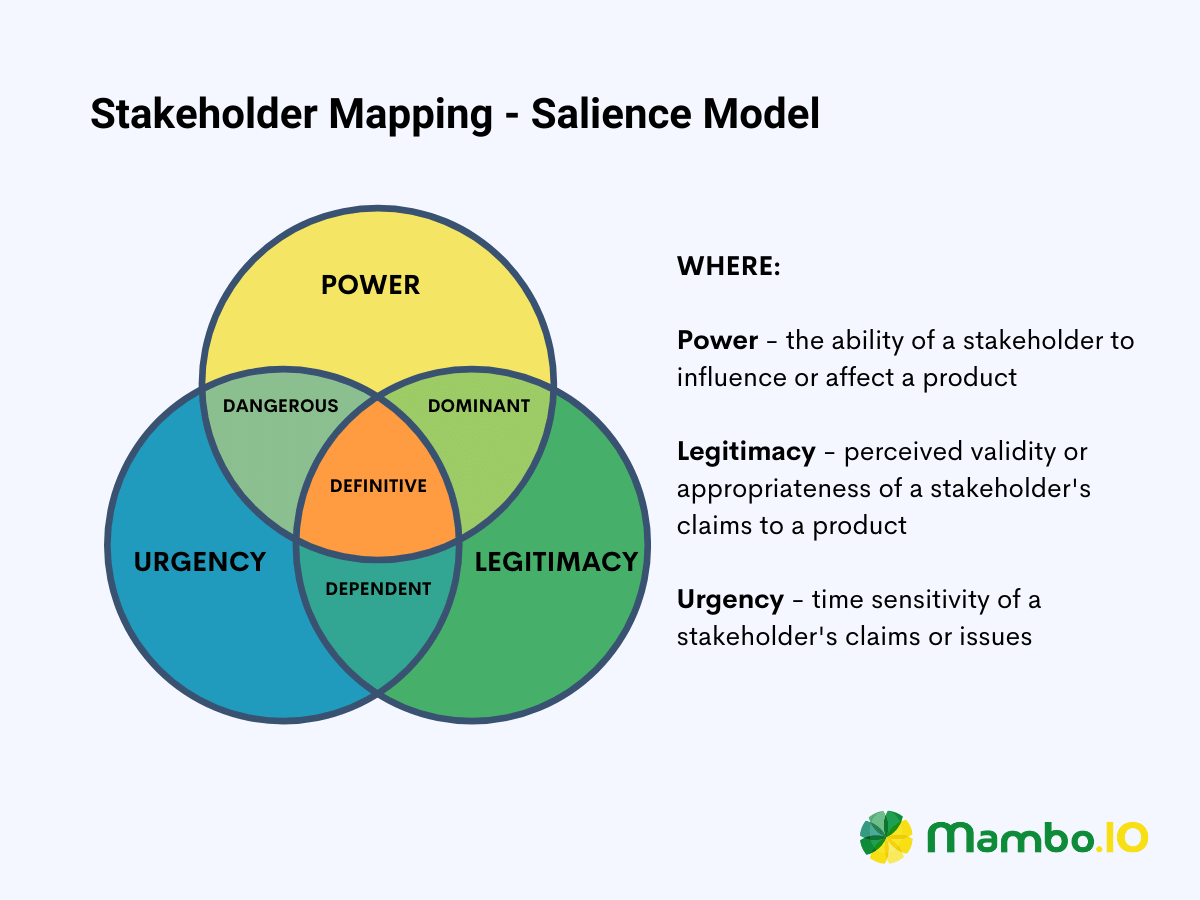
#4. Stakeholder prioritisation
After mapping your stakeholders, your next step is prioritising them according to their importance to the product lifecycle. Remember this: not all stakeholders are as equally impactful as the others. For this reason, you must prioritise the key stakeholders that hold the most influence over your product.
#5. Stakeholder engagement
Finally, you have a complete and updated list of your stakeholders. With this information, you can actively manage your relationships with stakeholders throughout the product’s lifecycle. Stakeholder engagement is where you formulate a battle plan for communicating and interacting with them.
For this reason, we highly recommend you create your stakeholder communication plan. Create one that outlines the channels and frequency of communications between you and each product stakeholder.
How to create a stakeholder management plan
A well-structured stakeholder product management plan can help you navigate the complex web of relationships and interests surrounding your product. Here’s a six-step process for creating an effective stakeholder management plan.
#1. Set clearly defined objectives
A set of clearly defined objectives is the best compass you can get when making a successful stakeholder management plan. Below are some of the questions to ask when defining objectives for your stakeholder management plan:
- How can we establish and nurture strong and mutual relationships with our key stakeholders?
- What methods can we use to better understand each stakeholder group’s needs and concerns?
- What plan can we implement to resolve conflicts and address stakeholder disagreements?
- What strategies and protocols should we develop for managing stakeholder relationships during crises or unexpected events?
- How can we actively seek and incorporate stakeholder feedback to improve our product continuously?
#2. Identify stakeholders involved
Stakeholder identification is a crucial part of creating an effective stakeholder management plan. To identify the stakeholders involved with your product, you’ll need to use the stakeholder analysis. But before you start, always cast a wide net so no one gets overlooked or left behind.
#3. Analyse stakeholders
Once you’ve identified the stakeholders, your next step is to analyse their influence, interest, and impact on your project. You can use stakeholder management tools like the stakeholder matrix to categorise them based on their power and interest level.
Below are some of the methods you can use to scrutinise your stakeholders:
- Power-interest grid
- Influence-impact grid
- Power-influence grid
- Importance-influence grid
- Stakeholder analysis matrix
#4. Develop an engagement plan
Next, develop strategies for effectively engaging with each stakeholder group. Always remember that every stakeholder has different communication needs and preferences. One of the keys to successful stakeholder management is prioritising those with high impact on your project since they should receive more attention.
#5. Assign resources and responsibilities to stakeholders
Then, start allocating the necessary resources to manage stakeholder relationships effectively. Start assigning tasks to everyone involved in your stakeholder management plan based on their expertise. Don’t forget to set someone as the person accountable for each stakeholder group.
Additionally, you might encounter intersecting projects and activities that align with your plans. These can be excellent opportunities for collaboration that can optimise your resources while improving stakeholder experience.
#6. Monitor and report your progress
Finally, monitor your stakeholder engagement and relationships with stakeholders throughout the product lifecycle. This ongoing process will require you to gather feedback, address concerns, and adapt your strategies whenever necessary. Remember to regularly report your progress to stakeholders and keep them up-to-date about project developments.
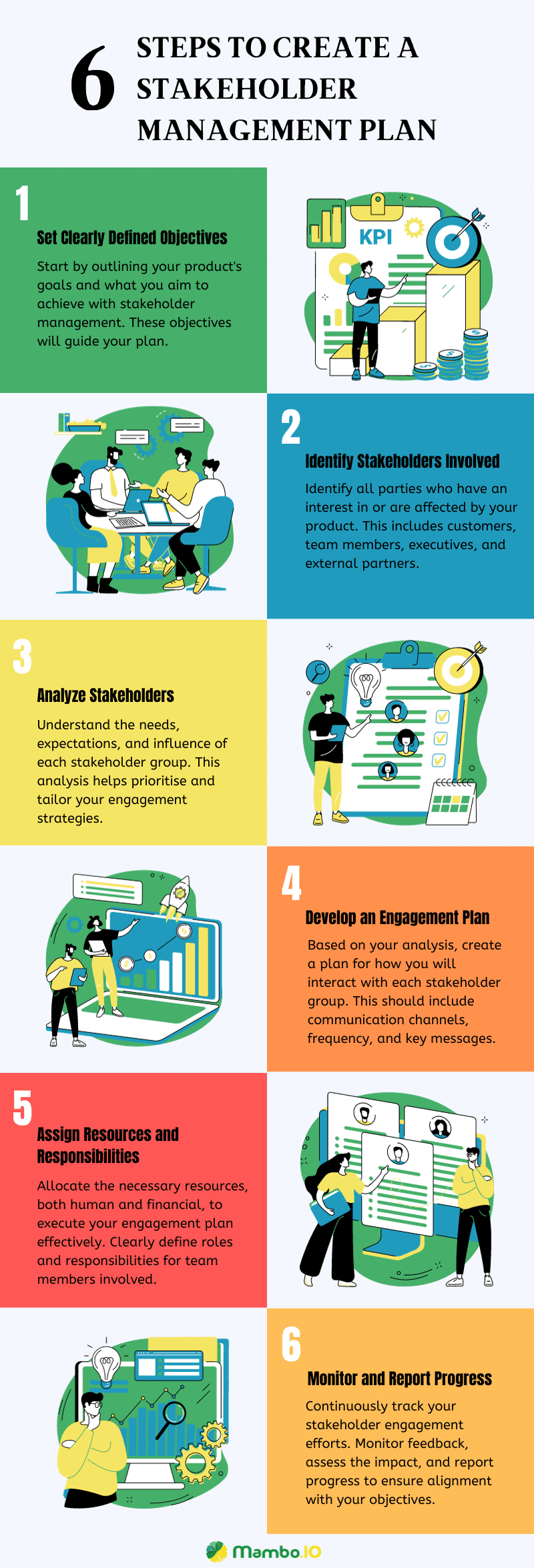
Stakeholder management software to use in 2023
We get it; managing stakeholders and collaborating with them sounds like a tedious task. That’s because it is!
The good news is we don’t have to do it the hard way. There is a lot of software today that makes stakeholder management ten times easier than it should be. Look at the best stakeholder management software product managers should use in 2023.
Kahootz
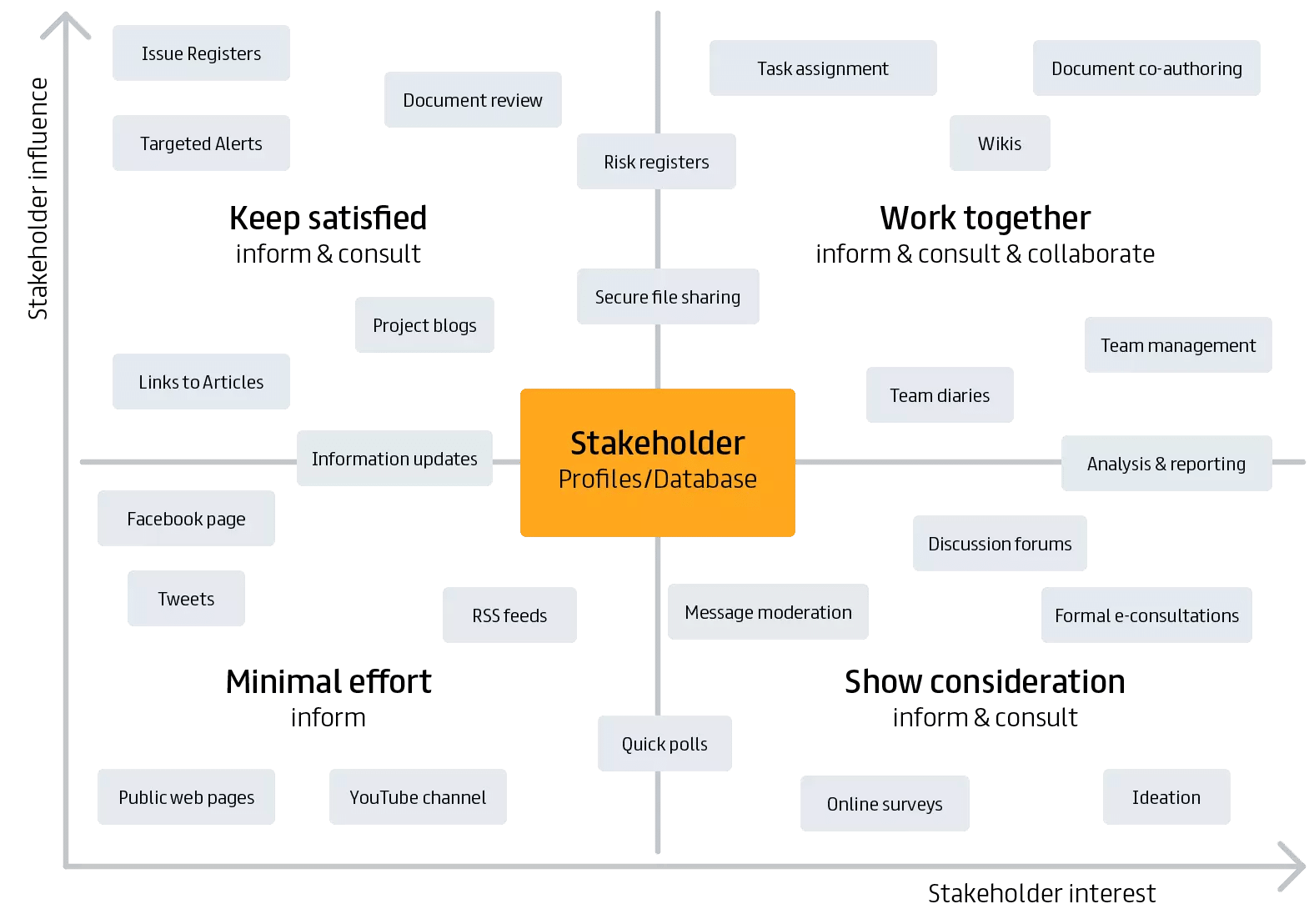
Source: Kahootz
Kahootz is a stakeholder relationship management platform designed to maximise the impact. It enables product managers to map stakeholder groups based on influence and impact, each with customisable profiles for segmentation. It also has user-friendly dashboards and visualisations that provide insights into shared ideas and opportunities.
Simply Stakeholders
Simply Stakeholders is a stakeholder relationship management platform that lives up to its name due to its simplicity and intuitiveness. It’s designed for handling complex relationships not driven by sales. This is an excellent alternative to the traditional spreadsheets that no longer fulfil their duty of tracking important product stakeholders.
Darzin
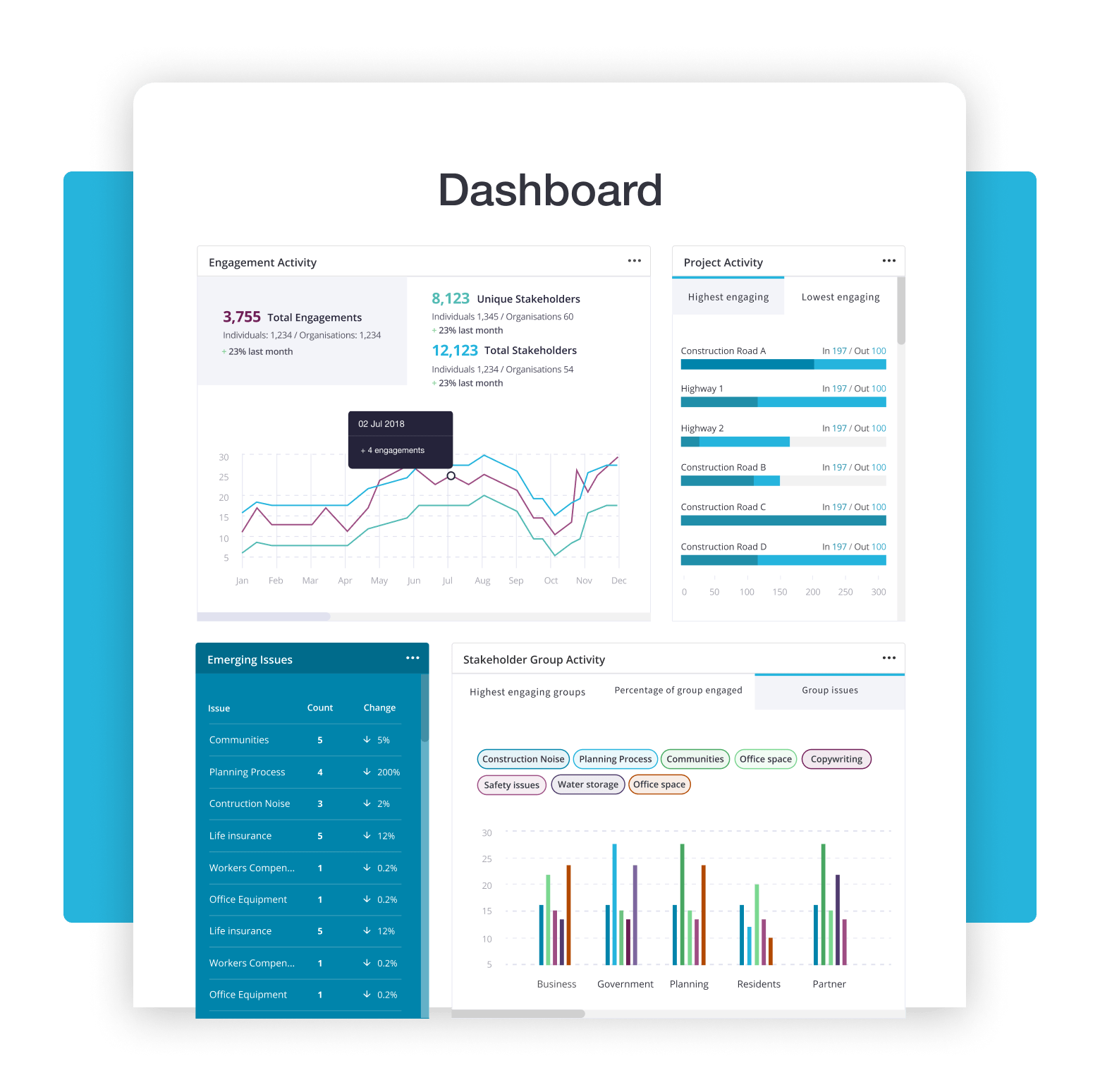
Source: Darzin
Darzin is one of the top-rated stakeholder management tools because it simplifies stakeholder management effortlessly. It’s user-friendly, requiring only a few clicks to understand, manage, and engage with your stakeholders. You can also use Darzin to easily track connections, conversations, sentiments, and interactions with stakeholders and the entire organisation.
Jambo
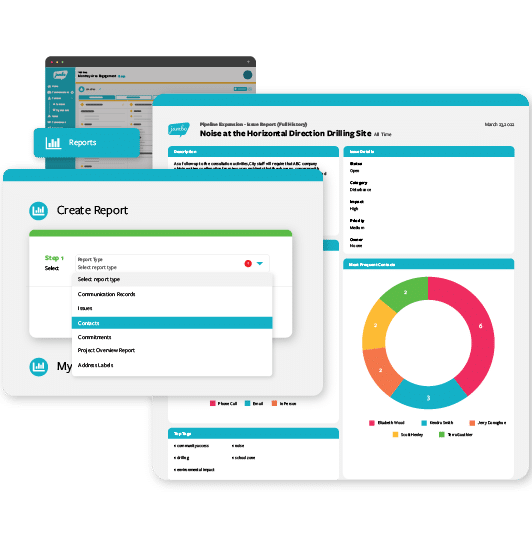
Source: Jambo
Jambo is a versatile stakeholder management software designed for small to medium-sized organisations. It lets you map stakeholders, create profiles, and plan stakeholder engagement activities. Jambo emphasises user-friendliness and affordability, making it an ideal option for budget-conscious businesses with small stakeholder teams.
Stakeholder Management Tips and Best Practices
#1. Focus on the key stakeholders
As mentioned earlier, not all stakeholders are equal. Because of this, it’s crucial for you as a product manager, to determine who can influence and impact your product. The key stakeholders, like the CMO and CTO, are just some who will spearhead your product’s trajectory toward better outcomes.
#2. Build trust amongst stakeholders
Much like any other relationship, trust is the foundation of a productive stakeholder relationship. With this in mind, product managers must work diligently to establish and maintain stakeholder trust. This task involves delivering on promises, demonstrating transparency, and actively listening to their concerns.
#3. Establish clear goals and expectations
If you want a smooth-sailing product lifecycle, you must ensure every stakeholder is on board with the product vision. Your relationships with stakeholders will help immensely when things don’t go as planned, especially when their expectations are realistic. Bad things tend to happen unexpectedly; when it does, you’ll need your stakeholders to stick to the product goals.
#4. Engage the stakeholders early and regularly
Engaging with stakeholders early in product development can help you gather valuable insights. Doing so also aligns stakeholder expectations with the product’s goal. If you communicate with your stakeholders regularly, they will stay informed and feel valued throughout the project.
#5. Keep the stakeholders involved
One of the best ways to keep your stakeholders invested in your product’s success is by involving them in your decision-making process. If you give them the opportunity to express their concerns, they will feel more appreciated, thus making your relationships stronger. Ultimately, this will lead to more results-oriented decisions.
#6. Hold stakeholders accountable and don’t tolerate inappropriate behaviour
Being a stakeholder in the product development process means committing fully to your responsibilities. And as a product manager, you must keep every stakeholder accountable for their commitment to the product. More importantly, you should promptly address inappropriate behaviour to maintain a positive working environment.
Download your free
“Gamification Guide”
Get your PDF now and start transforming your approach to digital engagement!
Latest Posts
Wrapping Up
Stakeholder management is a critical process in product management, and the same can go for a sound stakeholder management plan.
Here at Mambo.io, we believe all relationships built around the product are critical for its success. It’s also one of the reasons why we strongly advocate for product managers to have strong leadership skills. If they can lead product people, they can surely manage their stakeholders effectively. No man is an island, and every product manager must know how to manage the relationships between each stakeholder.
Machine Learning In Finance: 12 Essential Applications
The impact of machine learning on finance is significant. Thanks to this technology, financial institutions are now equipped to make efficient decisions. Through the analysis of data sets, machine learning […]
How To Create Interactive Compliance Training For Bank Employees
Banking compliance training isn’t just another task. It’s the stage where everything else performs. Banks must navigate a myriad of regulations and laws. After all, this is a trust-driven, high-stakes […]
How Fintech Apps Are Using Gamification To Increase User Engagement
Discover how gamification in fintech is revolutionizing financial engagement, making banking fun & boosting user loyalty.





